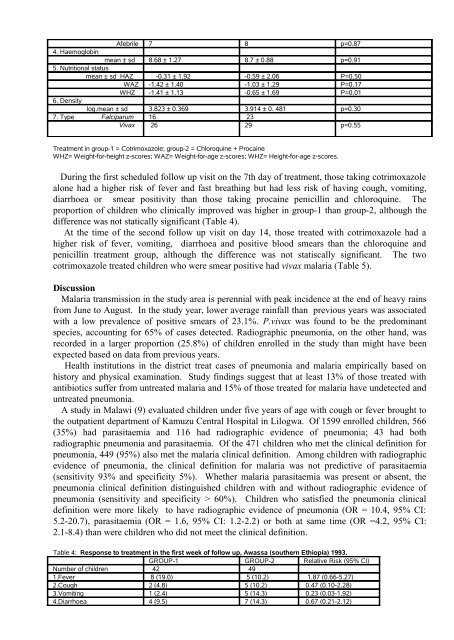Original article - Ethiopian Review
Original article - Ethiopian Review
Original article - Ethiopian Review
- No tags were found...
You also want an ePaper? Increase the reach of your titles
YUMPU automatically turns print PDFs into web optimized ePapers that Google loves.
Afebrile 7 8 p=0.874. Haemoglobinmean ± sd 8.68 ± 1.27 8.7 ± 0.88 p=0.915. Nutritional statusmean ± sd HAZ -0.31 ± 1.92 -0.59 ± 2.06 P=0.50WAZ -1.42 ± 1.40 -1.03 ± 1.29 P=0.17WHZ -1.41 ± 1.13 -0.65 ± 1.69 P=0.016. Densitylog.mean ± sd 3.823 ± 0.369 3.914 ± 0. 481 p=0.307. Type Falciparum 16 23Vivax 26 29 p=0.55Treatment in group-1 = Cotrimoxazole; group-2 = Chloroquine + ProcaineWHZ= Weight-for-height z-scores; WAZ= Weight-for-age z-scores; WHZ= Height-for-age z-scores.During the first scheduled follow up visit on the 7th day of treatment, those taking cotrimoxazolealone had a higher risk of fever and fast breathing but had less risk of having cough, vomiting,diarrhoea or smear positivity than those taking procaine penicillin and chloroquine. Theproportion of children who clinically improved was higher in group-1 than group-2, although thedifference was not statically significant (Table 4).At the time of the second follow up visit on day 14, those treated with cotrimoxazole had ahigher risk of fever, vomiting, diarrhoea and positive blood smears than the chloroquine andpenicillin treatment group, although the difference was not statiscally significant. The twocotrimoxazole treated children who were smear positive had vivax malaria (Table 5).DiscussionMalaria transmission in the study area is perennial with peak incidence at the end of heavy rainsfrom June to August. In the study year, lower average rainfall than previous years was associatedwith a low prevalence of positive smears of 23.1%. P.vivax was found to be the predominantspecies, accounting for 65% of cases detected. Radiographic pneumonia, on the other hand, wasrecorded in a larger proportion (25.8%) of children enrolled in the study than might have beenexpected based on data from previous years.Health institutions in the district treat cases of pneumonia and malaria empirically based onhistory and physical examination. Study findings suggest that at least 13% of those treated withantibiotics suffer from untreated malaria and 15% of those treated for malaria have undetected anduntreated pneumonia.A study in Malawi (9) evaluated children under five years of age with cough or fever brought tothe outpatient department of Kamuzu Central Hospital in Lilogwa. Of 1599 enrolled children, 566(35%) had parasitaemia and 116 had radiographic evidence of pneumonia; 43 had bothradiographic pneumonia and parasitaemia. Of the 471 children who met the clinical definition forpneumonia, 449 (95%) also met the malaria clinical definition. Among children with radiographicevidence of pneumonia, the clinical definition for malaria was not predictive of parasitaemia(sensitivity 93% and specificity 5%). Whether malaria parasitaemia was present or absent, thepneumonia clinical definition distinguished children with and without radiographic evidence ofpneumonia (sensitivity and specificity > 60%). Children who satisfied the pneumonia clinicaldefinition were more likely to have radiographic evidence of pneumonia (OR = 10.4, 95% CI:5.2-20.7), parasitaemia (OR = 1.6, 95% CI: 1.2-2.2) or both at same time (OR =4.2, 95% CI:2.1-8.4) than were children who did not meet the clinical definition.Table 4: Response to treatment in the first week of follow up, Awassa (southern Ethiopia) 1993.GROUP-1 GROUP-2 Relative Risk (95% CI)Number of children 42 491.Fever 8 (19.0) 5 (10.2) 1.87 (0.66-5.27)2.Cough 2 (4.8) 5 (10.2) 0.47 (0.10-2.28)3.Vomiting 1 (2.4) 5 (14.3) 0.23 (0.03-1.92)4.Diarrhoea 4 (9.5) 7 (14.3) 0.67 (0.21-2.12)




![to read the full report [pdf, Amharic] - Ethiopian Review](https://img.yumpu.com/52737829/1/190x245/to-read-the-full-report-pdf-amharic-ethiopian-review.jpg?quality=85)











